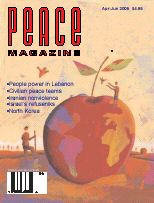
Peace Magazine Apr-Jun 2005, page 28. Some rights reserved.
Search for other articles by Ed Silva here
Mel Hurtig. Toronto: McClelland & Stewart 2004, $19.99
Mel Hurtig has written a powerful critique of the Bush government's Ballistic Missile Defence (BMD) system. He suggests that BMD is a tempting, but false, illusion.
To begin with, he notes the continuing failure of the emerging system. In test after test, nothing seems to work very well. Clearly, the BMD's necessary technologies don't yet exist, and are too expensive to create quickly.
However, even if the system's technologies worked better, the BMD would still not be very good. Simply put, missile offence tends to trump missile defence.
At launch, offensive missiles have the advantage of surprise. In mid-flight cruise, missile decoys can confuse defenders. At re-entry, missiles can surprise again by splitting into multiple vehicles aimed at different places, and even successful intercepts rain radio-active waste on the defenders.
Beyond technique, the BMD both masks and manifests enduring US political and economic interests that are somewhat separate from Canadian concerns.
In 1960, liberal Republican President and retired General Dwight D. Eisenhower warned of an emerging Military-Industrial Complex (MIC) fueled, in part, by the career ambitions of US military leaders.
In the 1980s, radical Republican President Ronald Reagan happily fed the MIC's growth, including Star Wars, BMD's prototype.
In Bush's neo-conservative 21st century, ever-increasing defence spending is justified by an ever-increasing emphasis on military insecurity. Fear of missile (and other) attacks makes reasonable the MIC's increasingly unaccountable and uncompetitive, cost-plus military procurement projects like the BMD.
Hurtig goes on to outline how BMD could spur nuclear proliferation, as Russia, China, and other nations come to sense BMD as part of an American space-based threat to their own security.
Finally, Hurtig suggests that Canada should not participate in Washington's BMD scheme. Rather, we should organize alternative uses for our energies, existing technologies, and taxes; uses that more nearly serve Canadian interests and values. For example, our security is increased when visible social problems -- homelessness, poverty, racism -- are solved, rather than when fearful and expensive nightmares define public policy.
Hurtig has written a valuable and useful book on a significant issue. It cites many voices, often at some length, gives a good sense of the over-all debate, and it clearly points the way forward. Indeed, at the most general level, Hurtig's book implies that Washington's weapons schemes can be defeated by mobilizing the kinetic social energy of what Jonathan Schell has called the Second Super Power: world-wide civil society and public opinion.
Reviewed by Ed Silva, a retired sociologist in Toronto.
Peace Magazine Apr-Jun 2005, page 28. Some rights reserved.
Search for other articles by Ed Silva here